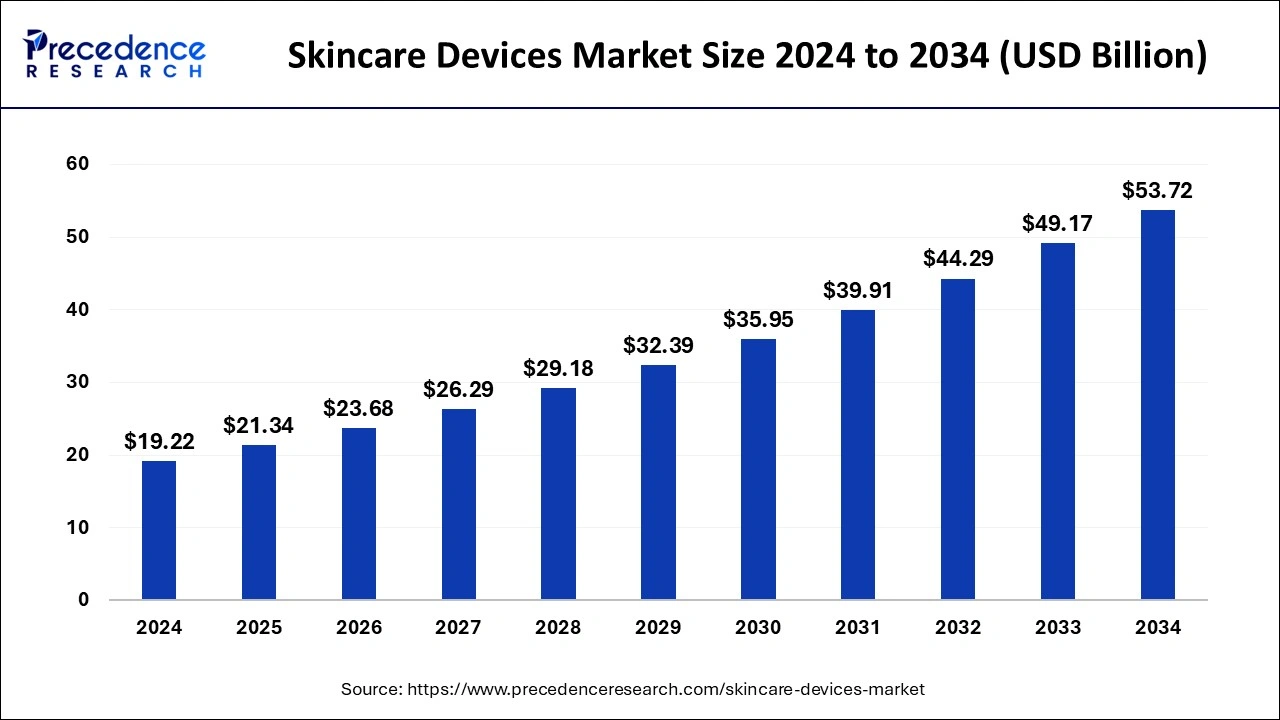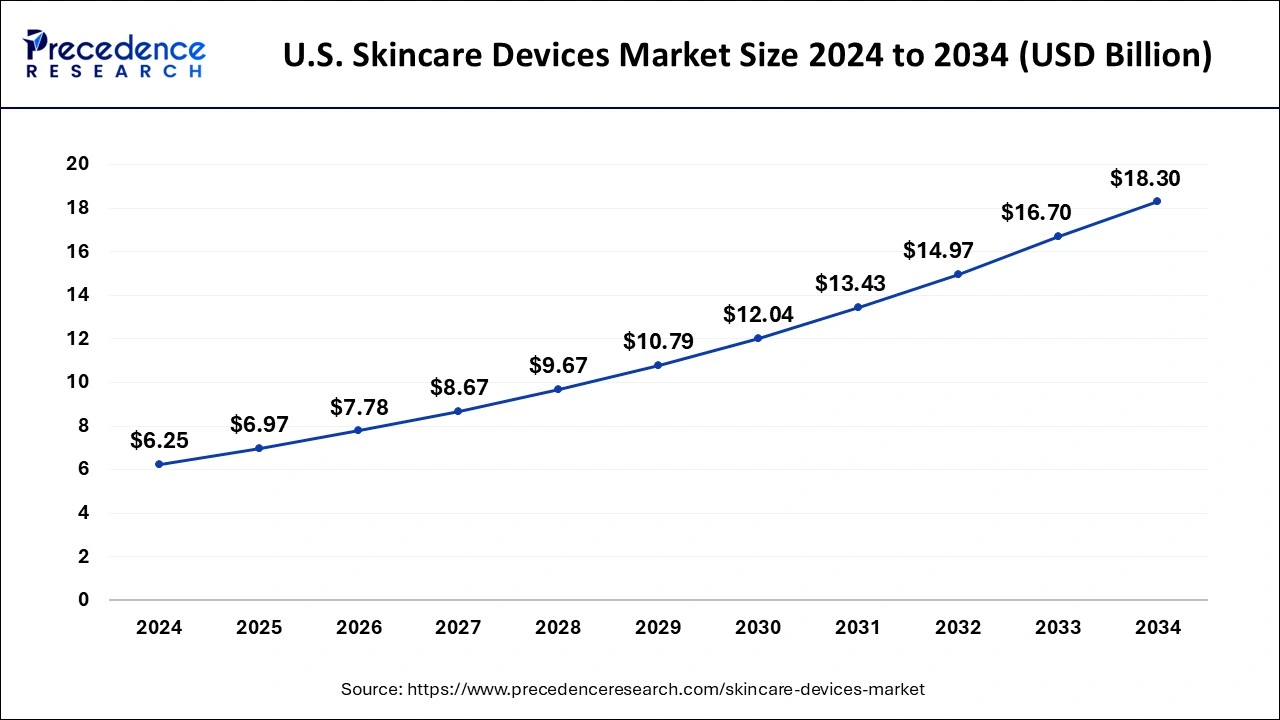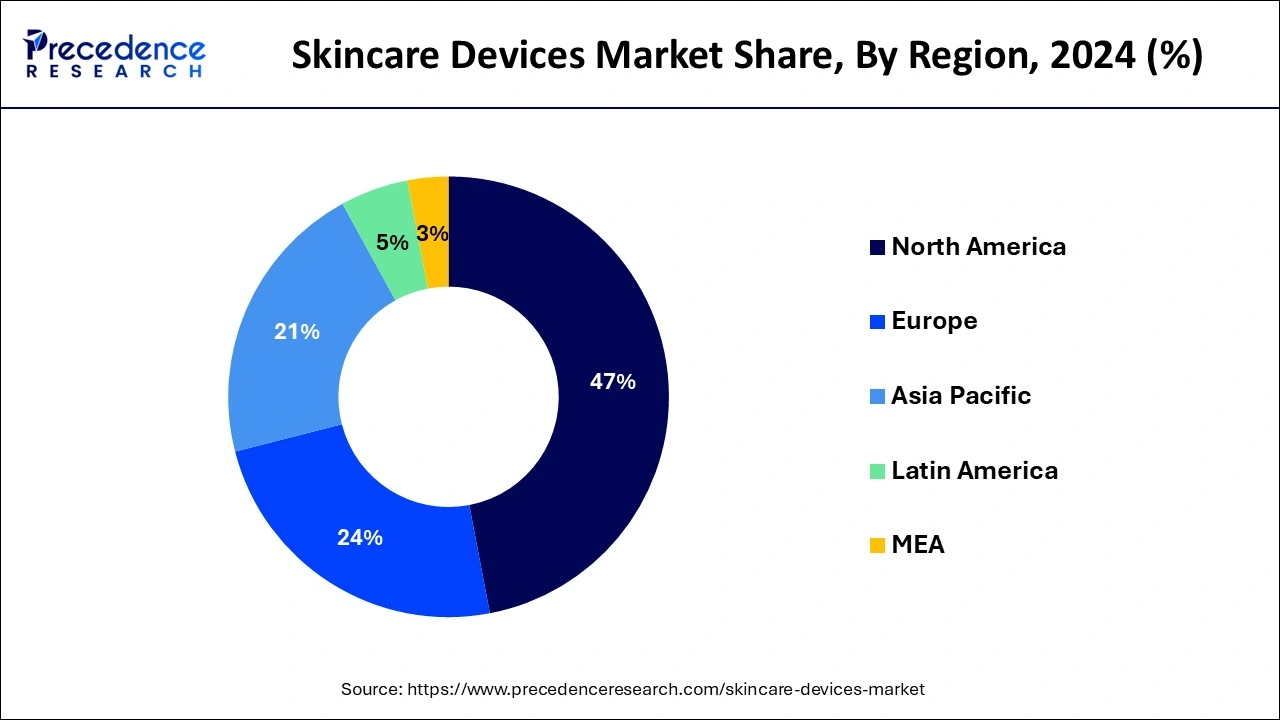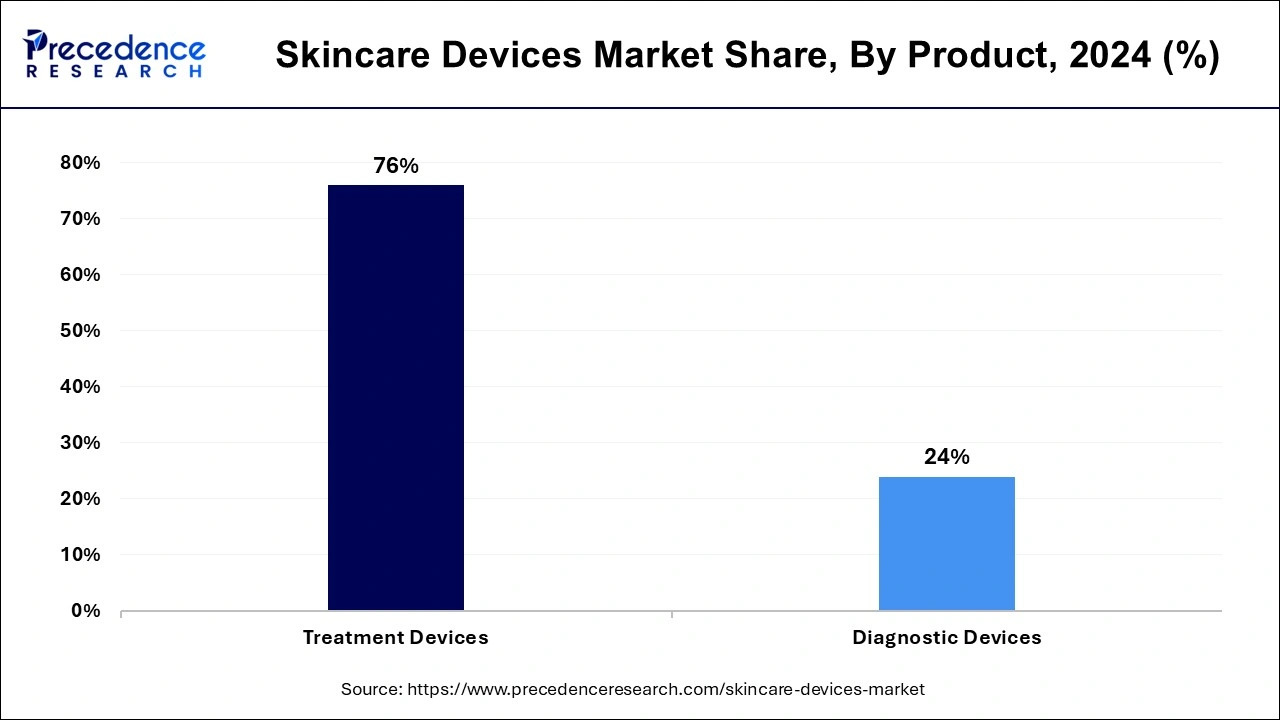February 2025
The global skincare devices market size is evaluated at USD 21.34 billion in 2025 and is forecasted to hit around USD 53.72 billion by 2034, growing at a CAGR of 10.83% from 2025 to 2034. The North America market size was accounted at USD 9.03 billion in 2024 and is expanding at a CAGR of 10.85% during the forecast period. The market sizing and forecasts are revenue-based (USD Million/Billion), with 2024 as the base year.
The global skincare devices market size accounted for USD 19.22 billion in 2024 and is predicted to increase from USD 21.34 billion in 2025 to approximately USD 53.72 billion by 2034, expanding at a CAGR of 10.83% from 2025 to 2034.

The U.S. skincare devices market size was exhibited at USD 6.25 billion in 2024 and is projected to be worth around USD 18.30 billion by 2034, growing at a CAGR of 11.34% from 2025 to 2034.

North America has held the largest revenue share 47% in 2024. In North America, the skincare devices market is characterized by a strong focus on technological innovation and consumer-driven demand for advanced beauty solutions. Consumers in this region prioritize effective and convenient skincare routines, driving the adoption of high-tech devices such as facial cleansing brushes, LED therapy masks, and microdermabrasion devices. Moreover, the market is witnessing an increasing emphasis on non-invasive treatments, particularly amid the COVID-19 pandemic, as individuals seek alternatives to in-person dermatological procedures.
Asia Pacific is estimated to observe the fastest expansion. Skincare devices are gaining popularity due to a cultural emphasis on skincare and youthful appearance. Countries like South Korea and Japan have a well-established market for beauty and skincare products, which extends to skincare devices. The region also experiences a surge in demand for smart skincare devices integrated with mobile apps, offering personalized skincare regimens. The Asian market is known for its early adoption of technology, and skincare devices align with this tech-savvy consumer base, driving continuous growth and innovation in the industry.
The skincare devices market reflects a growing interest in anti-aging solutions, as consumers seek effective tools to combat skin aging and maintain a youthful appearance. High-quality and technologically advanced devices, including radiofrequency machines and microneedling tools, are gaining traction. The Asia Pacific market also places importance on eco-friendly and sustainable skincare options, encouraging the development of devices with environmentally conscious features and materials.

The skincare devices market refers to the industry segment dedicated to the manufacturing and distribution of specialized devices designed to enhance skincare routines and address various skin concerns. These devices can include technologies like facial cleansing brushes, LED therapy devices, microdermabrasion machines, and more.
The skincare devices market is marked by a swift pace of technological progress and heightened consumer awareness regarding skincare solutions extending beyond traditional topical products. The market has seen a substantial surge in the demand for at-home skincare devices, fueled by the desire for convenient and effective methods to attain healthier and more radiant skin. Consequently, the skincare devices market is characterized by its dynamic and forward-looking nature, with ongoing product innovations focused on enhancing the user experience and delivering improved outcomes.
The skincare devices market is witnessing robust growth driven by several factors. The market is characterized by rapid technological advancements and increasing consumer awareness regarding skincare solutions beyond topical products. The demand for at-home skincare devices has grown significantly as consumers seek effective and convenient ways to achieve healthier skin. The integration of IoT and smart technology into skincare devices has further revolutionized the market, allowing users to personalize their skincare routines for optimal results.
The market is driven by several factors including the rising demand for non-invasive and minimally invasive skincare treatments, especially for anti-aging purposes. The market benefits from the growing preference for DIY skincare routines and the increasing adoption of advanced beauty technologies. Additionally, the aging population and the desire for youthful skin contribute to market growth.
However, the industry faces challenges such as stringent regulatory requirements and the need for clinical validation for some devices. The competitive landscape is marked by a multitude of players introducing innovative products to gain a competitive edge.
For businesses, this market presents promising opportunities, especially in the development of IoT-based skincare devices and personalized beauty solutions. As technology continues to evolve and consumer demand for advanced skincare devices remains strong, the skincare devices market is poised for sustained growth and innovation.
| Report Coverage | Details |
| Growth Rate from 2025 to 2034 | CAGR of 10.83% |
| Market Size in 2025 | USD 21.34 Billion |
| Market Size in 2024 | USD 19.22 Billion |
| Market Size by 2034 | USD 53.72 Billion |
| Largest Market | North America |
| Base Year | 2024 |
| Forecast Period | 2025 to 2034 |
| Segments Covered | Product, Application, and End Use |
| Regions Covered | North America, Europe, Asia-Pacific, Latin America, and Middle East & Africa |
Rising demand for non-invasive solutions and increasing aging population
The skincare devices market is experiencing significant growth due to two key drivers, the rising demand for non-invasive solutions and the increasing aging population. As consumers increasingly prioritize safer and less painful alternatives to surgical procedures, the market is responding with a range of skincare devices that offer effective solutions. These devices, which include lasers, radiofrequency devices, and microdermabrasion tools, provide visible results without the need for invasive techniques. These devices provide users with visible results, reduced downtime, and fewer side effects, making them an attractive choice for individuals looking to address various skin concerns.
Moreover, the global population is aging, and with aging comes specific skincare needs. The elderly demographic often faces age-related skin issues like wrinkles, fine lines, and sagging skin. Skincare devices that target these concerns, such as anti-aging devices and skin-tightening tools, have gained immense popularity.
Consequently, skincare devices tailored to address these issues, such as anti-aging devices and skin-tightening tools, are experiencing surging demand. This trend is driven by the desire of the aging population to maintain youthful and healthy-looking skin, making these devices increasingly popular choices. These factors collectively contribute to the ongoing expansion of the skincare devices market.
Limited regulatory framework and cost constraints
The skincare devices market faces restraints primarily due to limited regulatory frameworks and cost constraints. Firstly, the skincare device industry often lacks comprehensive regulatory oversight compared to pharmaceuticals or medical devices. This gap raises concerns about product safety, quality, and efficacy, which can deter both manufacturers and consumers. The absence of stringent regulations may result in substandard devices entering the market, potentially harming users and undermining trust in the industry.
Moreover, there is a cost constraint as there is a rising demand for advanced skincare devices, and many potential consumers are deterred by the high price tags associated with cutting-edge technology. These devices often require significant research and development investments, which can drive up production costs. As a result, manufacturers may struggle to make these products accessible to a broader consumer base. This cost barrier limits market expansion and restricts the benefits of skincare devices to a select group of consumers. Addressing these challenges through enhanced regulations and cost-effective innovations is crucial to unlocking the full potential of the skincare devices market.
Consumer awareness and technological advancements
Consumer awareness and technological advancements are two pivotal factors propelling the robust demand for skincare devices. The growing awareness among consumers about skincare and their desire for effective solutions has fueled the demand for skincare devices. These devices provide professional-grade treatments that can be conveniently used at home. Consumers are increasingly inclined to take control of their skincare routines, contributing significantly to the market's expansion.
Moreover, continuous technological advancements have revolutionized the skincare devices market. The integration of the Internet of Things (IoT) and smart technology into these devices has elevated their functionality and user experience. Smart skincare devices can now analyze skin conditions, provide personalized recommendations, and track progress over time. The customization and convenience offered by modern skincare devices align perfectly with the expectations of today's consumers. This alignment has led to a surge in demand for these innovative products. As technology in the skincare device industry continues to advance, with devices becoming increasingly sophisticated, the market is poised for further expansion. Consumers are likely to rely more heavily on these devices to meet their evolving skincare needs.
Impact of COVID-19
The skincare devices market, like many others, experienced the impact of the COVID-19 pandemic. In the initial stages of the pandemic, there was a slowdown in production and disruptions in the supply chain due to lockdowns and restrictions. This led to a temporary dip in market growth. Additionally, the economic uncertainty and financial constraints faced by consumers during the pandemic's peak affected their willingness to invest in non-essential products like skincare devices.
However, the market demonstrated resilience as the pandemic progressed. With more people staying at home and seeking at-home skincare solutions, there was a shift in consumer behavior. This led to a surge in demand for skincare devices, particularly those offering features for professional-grade treatments at home. Consumers were keen to maintain their skincare routines despite limited access to salons and spas. As a result, the market rebounded, and many skincare device manufacturers adapted to the changing landscape by launching innovative products to cater to the growing demand for at-home skincare solutions. This shift in consumer preferences and the industry's ability to respond with relevant offerings helped mitigate the pandemic's initial adverse effects on the skincare devices market, ultimately driving its recovery and growth.
According to the product, the treatment devices segment has held a 76% revenue share in 2024. Treatment devices, on the other hand, encompass a wide range of tools used for skincare treatments, including LED therapy devices, microdermabrasion machines, and laser devices. The trend in this category is a growing preference for non-invasive and painless treatment options. Devices that offer multiple treatment modalities in one unit are gaining popularity, providing users with versatile and cost-effective skincare solutions. Moreover, the development of portable and handheld treatment devices allows for greater convenience and at-home use, contributing to the market's expansion as consumers seek accessible and effective skincare treatments.

The diagnostic devices segment is anticipated to expand at a significant CAGR of 12.8% during the projected period. Diagnostic devices in the skincare devices market refer to tools and equipment designed to assess and analyze various skin conditions. These devices include digital skin analyzers and UV radiation meters. The trend in this segment is an increasing focus on accuracy and precision, with advanced diagnostic devices providing detailed insights into skin health. Additionally, the integration of artificial intelligence and machine learning is enhancing diagnostic capabilities, allowing for more personalized skincare recommendations based on individual skin conditions.
Based on the application, the hair removal segment is anticipated to hold the largest market share of 23% in 2024. In the skincare devices market, hair removal refers to the use of devices such as laser hair removal systems and IPL (Intense Pulsed Light) devices to eliminate unwanted hair from various body areas. This segment has witnessed significant growth due to the increasing demand for long-lasting and convenient hair removal solutions. Consumers prefer these devices for their efficiency and the ability to achieve salon-quality results at home.
On the other hand, the skin rejuvenation segment is projected to grow at the fastest rate over the projected period. Skin rejuvenation in the skincare devices market includes devices like microdermabrasion machines, radiofrequency devices, and LED therapy devices. These devices are designed to address fine lines, wrinkles, uneven skin tone, and texture. The skin rejuvenation segment is characterized by the growing preference for non-invasive and non-surgical treatments, as consumers seek to maintain youthful and healthy-looking skin. Technological advancements, such as the integration of smart features and app connectivity in these devices, are some of the trends contributing to the growth of both hair removal and skin rejuvenation segments in the skincare devices market.
In 2024, the hospitals segment had the highest market share of 56% on the basis of the end user. In hospitals, skincare devices are essential tools for dermatologists and other medical professionals to diagnose and treat various skin conditions. These devices range from advanced imaging systems for mole and lesion analysis to laser therapy equipment for skin resurfacing and scar removal. With the increasing prevalence of skin-related issues, hospitals are witnessing a growing trend in adopting these cutting-edge technologies to provide comprehensive dermatological care. Additionally, the integration of telemedicine and teledermatology services has allowed hospitals to extend their reach and offer remote consultations using skincare devices, enhancing patient accessibility and care.
The clinics segment is anticipated to expand at the fastest rate over the projected period. Dermatology clinics, specialized in skincare and cosmetic procedures, are at the forefront of adopting the latest skincare devices. They offer treatments such as microdermabrasion, chemical peels, and skin tightening using radiofrequency devices. A prominent trend in clinics is the integration of artificial intelligence (AI) and machine learning into skincare devices. These AI-powered tools assist dermatologists in precise diagnosis and personalized treatment planning. Furthermore, clinics focus on providing patients with minimally invasive and non-surgical skincare solutions, leveraging technologies like dermal fillers and phototherapy. Overall, clinics prioritize offering a wide range of advanced skincare services, often tailored to individual patient needs, using state-of-the-art devices for optimal results.
By Product
By Application
By End User
By Geography
For inquiries regarding discounts, bulk purchases, or customization requests, please contact us at sales@precedenceresearch.com
No cookie-cutter, only authentic analysis – take the 1st step to become a Precedence Research client
February 2025
April 2025
January 2025
January 2025